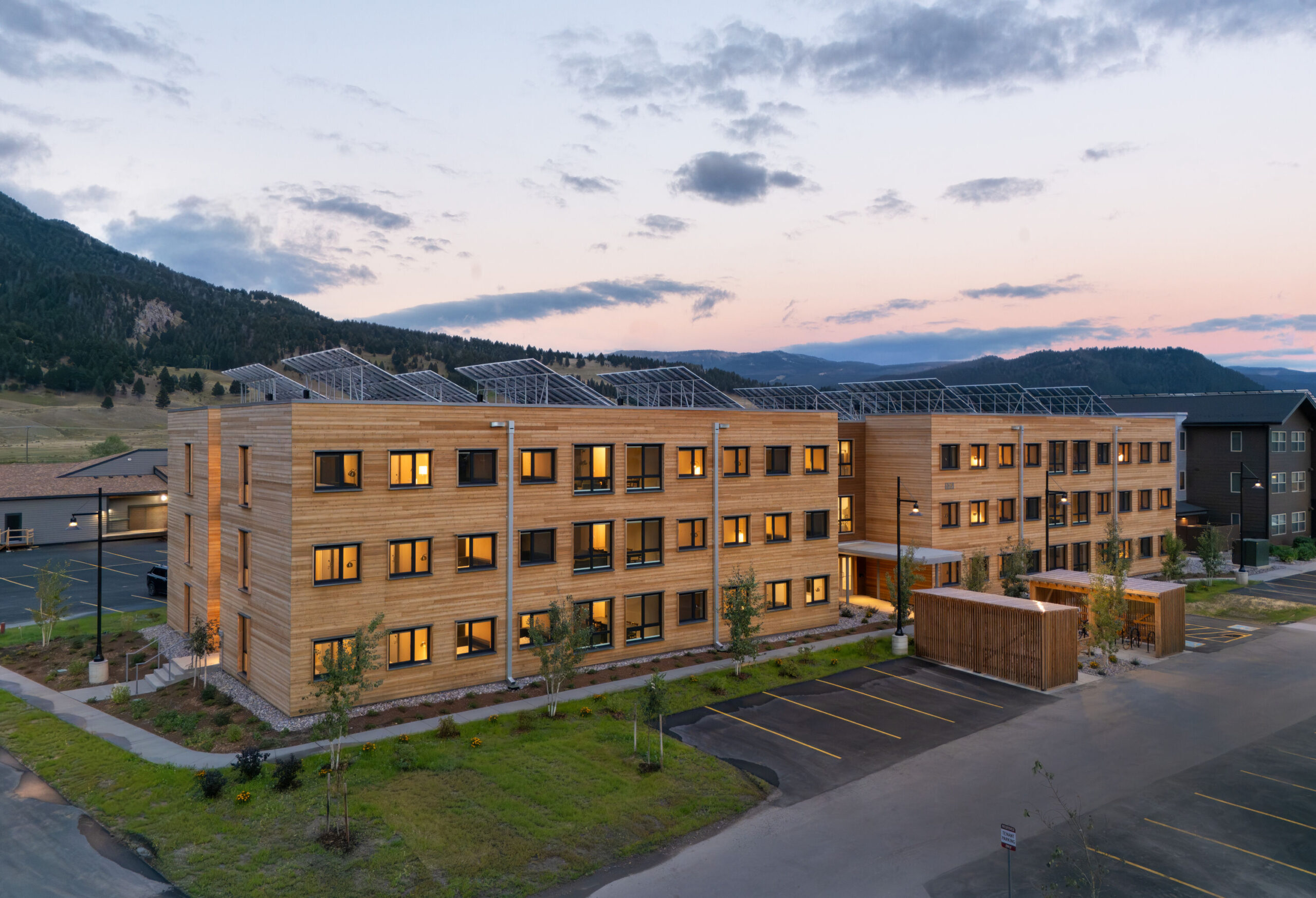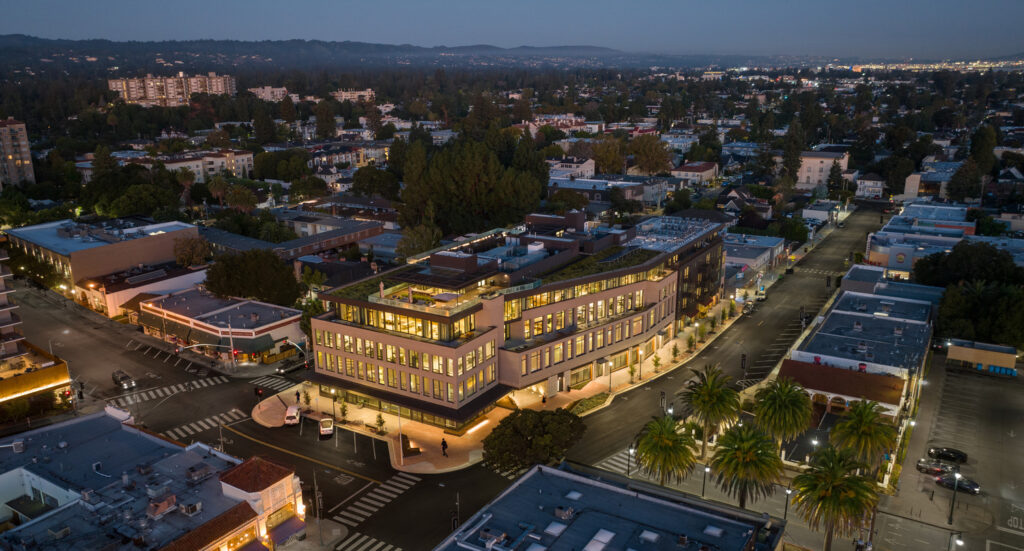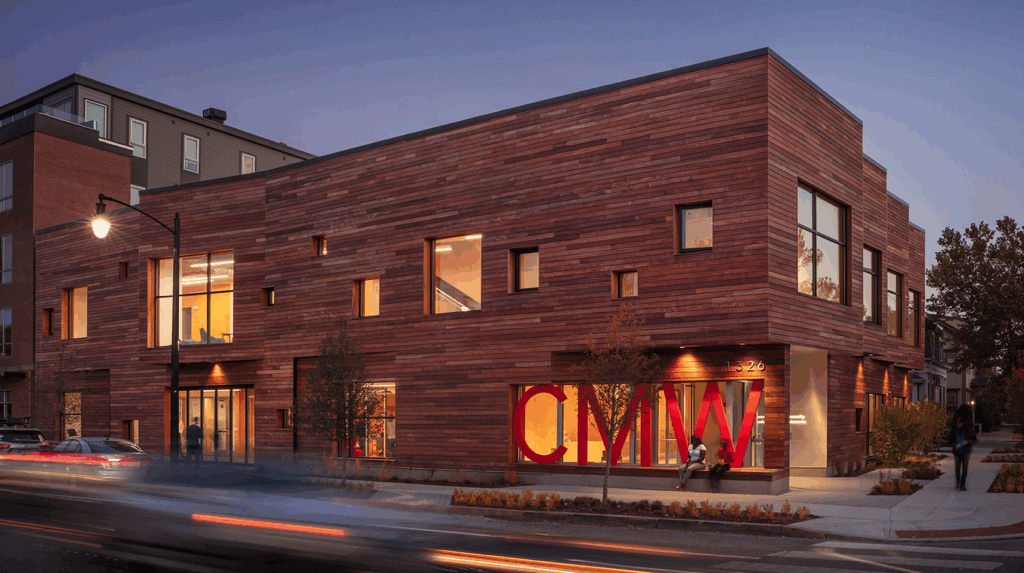Mass Timber, Multifamily
SuperBungalows
Multifamily developer SuperLA reinvents the beloved California bungalow court with mass timber.
Aaron van Schaik believes that affordable apartments don’t have to be banal white boxes—and he’s turning to one of California’s quintessential housing styles and a replicable, prefab mass timber construction model to prove it.
Van Schaik is founder and principal of Los Angeles–based SuperLA, a unique turnkey development firm that designs, constructs, owns, and operates rental properties.
His firm is on a mission to make apartment construction more cost-effective using prefabricated mass timber and light-frame wood construction. In the long term, Van Schaik plans to use those savings to provide sustainable, biophilic features such as exposed wood, filtered air and water, and large operable windows at affordable rates.
“Homes need not be white boxes with small windows and cold finishes,” van Schaik says. “We believe homes can be beautiful, high quality, environmentally sustainable, healthy and attainable, but it requires us to completely rethink the design and development process.”
That reinvention means investing in multifamily housing solutions as products, not one-off projects. It also means finding greater efficiencies in every phase, from pre-design and construction to operation and maintenance.

SuperBungalows
Thinking Outside the White Box
Van Schaik’s firm is putting this approach to the test with SuperLA’s first two apartment projects, both located in L.A.’s Silver Lake neighborhood: Marathon Street, a four-story market-rate rental nine-unit property, and Hyperion Avenue, a five-story 15-unit market-rate rental property.
SuperLA’s offerings currently include two unit types: a one-bedroom, one-bathroom home (SuperBungalow 1:1) and a two-bedroom, two-bathroom home (SuperBungalow 2:2). Marathon Street includes six 1:1 units and three 2:2 units. Hyperion Avenue will include only 1:1 units and will set two units aside for low-income renters.
Van Schaik hopes to increase the number of units for low-income renters over time as the firm scales up its operations.
Both projects incorporate cross-laminated timber (CLT) and light-frame wood in the primary structure, placing these projects among the growing number in California turning to this construction method, an increase driven by updates to the state’s building code in 2022 that allow for taller wood construction.

Doing the Homework: A Productized, Replicable Strategy
According to Van Schaik, typical multifamily projects waste time and money from start to finish. It can take 18 months to get a permit in hand, and then a design firm and contractor assemble a team of subcontractors that may have never worked together before, adding to potential inefficiencies.
Van Schaik isn’t the only one pointing out these inefficiencies. McKinsey & Company estimates that lagging construction productivity costs the global economy $1.6 trillion a year and that an overhaul of the sector could boost productivity by as much as 60%.
“We’re hyper-focused on how we can fix this using a productized, replicable approach that takes advantage of ongoing product refinement and offsite prefabricated mass timber and light-frame wood-constructed panels,” van Schaik says. “By acting as the architect, contractor, and, ultimately, the owner, we have more control over the process and can make it more affordable, faster, and better.”

SuperBungalows
But fast and affordable doesn’t mean cutting corners or cheaping out on materials. In fact, as an owner of market rental properties, SuperLA targets long-term durability and energy savings by building to meet high-performance standards.
“We are investing a lot in this [Marathon St] project, with the idea that by changing the conventional model and our approach, we will find savings over the long haul,” van Schaik says.

SuperBungalows Marathon Street
We're building the most streamlined, best housing product first, and then our goal is to introduce efficiencies across every stage of the development process, with a focus on off-site fabrication and the development of our products as a kit of parts.
California Bungalow Meets 21st-Century Timber Technology
To provide housing that’s highly appealing to potential residents, the SuperLA team is turning to a quintessentially Californian housing typology—the bungalow court—and reinterpreting it for the 21st century.
This mid-century housing configuration was made popular in the Golden State by its cost-effective, rapid construction. Bungalow court developments feature an arrangement of small, self-contained houses clustered around a shared courtyard, and are valued by occupants looking for green space and a more communal experience.
“SuperBungalow takes inspiration from Silver Lake’s mid-century modern aesthetic and L.A.’s widely popular bungalow court typology, which dates back to as early as 1910 and features no shared walls, lots of light and air on all sides, large attached terraces, and thoughtfully designed interior layouts,” van Schaik says.
Although only 350 original examples remain in L.A., the bungalow court’s sense of community and camaraderie has made it one of the city’s most beloved and desirable housing styles. In fact, some of Walt Disney’s animators are said to have lived in the bungalow court at 2908 Griffith Park Boulevard—less than 8 miles from SuperLA’s Hyperion Avenue project—and its whimsical style likely inspired the dwarves’ cottages in Snow White and the Seven Dwarves.

SuperBungalows
A Customizable Mass Timber-Built Kit of Parts
The SuperBungalows will take full advantage of offsite factory-built panelization. Marathon Street was constructed with light-frame wood walls built on site and panelized CLT floors and roofs.
Hyperion Avenue properties will be assembled with light-frame prefab walls and five-ply CLT floors and roofs—all arriving at the sites using just-in-time sequencing and expected to go up in just four weeks.
The majority of CLT will be left exposed, and interiors will include custom built-in wood millwork and cabinetry.
“We are seeing a 25% reduction in cost per SuperBungalow home at Hyperion Avenue compared to Marathon Street due to the reduction in design and construction timelines and cost efficiencies achieved as a result of our prefab approach,” van Schaik says.
The learnings from these two projects will further evolve the SuperBungalow 1:1 and SuperBungalow 2:2 products, essentially giving SuperLA a customizable mass timber kit-of-parts to use for future projects.
“As we look to future projects, we expect to reduce our cost per SuperBungalow home by over 50% by incorporating more off-site manufacturing of our components and automation of our design and construction,” van Schaik says.
To design some of the first hybrid light-fame mass timber buildings in L.A., SuperLA and its structural engineering team John A. Martin & Associates, Inc. (JAMA) collaborated closely with city officials to work through any seismic, fire, and code concerns.
“There’s going to be a tendency to scrutinize more and ask a lot of questions as we are breaking new ground with these projects,” says Parbi Boodaghian, senior project engineer at JAMA. “Nonetheless, the city was keen to work with us on it.”
“We were able to show to the city that seismically, both buildings are built for a worst-case scenario, analyzing the CLT diaphragms as both flexible and rigid,” Boodaghian says. “With Marathon Street and Hyperion Avenue, we have set a good precedent for future mass timber projects in L.A.”

SuperBungalows
Bright Lights, Timber City
When it comes to expanding the use of low-carbon prefab mass timber systems, both the city and the Central City Association of Los Angeles (CCA)—an advocacy group focused on a vibrant downtown—are increasingly on board.
In 2019, CCA and JAMA published a white paper that demonstrated how prefab mass timber systems could offer a faster, more affordable, and more sustainable way to build housing in the city.
“It’s really great to be in a city like L.A. that appreciates sustainability. They’re forward-thinking and would like to see more of these types of projects in the future,” van Schaik says.
As for future residents of the two projects, SuperLA has a growing list of prospective renters.
“It’s definitely going to be really interesting to see what happens when these hit the market and people realize that rental units don’t have to be cold white boxes,” van Schaik says.
SuperLA’s Marathon Street and Hyperion Avenue projects are expected to be completed in the summer of 2023 and winter of 2024, respectively.

SuperBungalows Marathon Street
Project Details
- Location:
- Los Angeles, CA
- Project Name:
- SuperBungalows
- Architect:
- Developer:
- Construction Manager/Contractor:
- Owner:
- Structural Engineer:
- Marathon St Size:
- 18,000 ft² | 4 Stories
- Hyperion Ave Size:
- 22,000 ft² | 5 Stories
- Type:
- Timber Products:















